Arms & Badges - Royal Arms of Canada, A Brief History
The Confederation of Canada
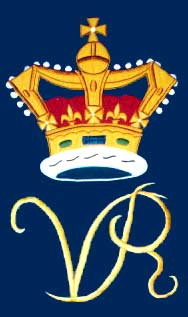
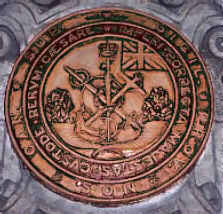 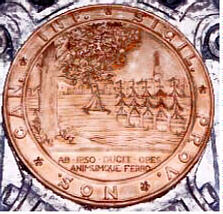 |
Prior to Confederation, no armorial bearings had been assigned to the various colonies in British North America, with the exception of the seventeenth-century grants to Nova Scotia and Newfoundland. Nevertheless, each colony possessed a great seal, and these contained distinctive emblematic devices. Two examples are shown here, both representing the obverse sides of the great seals deputed of Upper Canada (image on the right, above) and Lower Canada (image on the right, below), in use on successive seals from 1792 to 1832. The images illustrated here are actually carvings in the Parliament Buildings in Ottawa.
The Four Founding Provinces
The Confederation of Canada was created by an Act of the British Parliament and given Royal Assent by Queen Victoria. Each of the four founding provinces was then granted arms by Royal Warrant on May 6, 1868. This document also assigned to Canada as a whole the arms of the four provinces quartered together on one shield: Ontario, Quebec, Nova Scotia and New Brunswick. The arms of Nova Scotia were an entirely different design from those assigned c.1625, and which were reinstituted in 1928.Additional provinces and territories joined Canada in the years following Confederation, and there was a natural desire to augment the original arms with additional quarterings. Versions of these arms appeared that used five, seven, and finally nine quarterings. In many cases these were not legal arms but rather devices based on the provincial seal or assumed arms. This situation was largely rectified in the period 1905-1907, when arms were formally granted to no fewer than five provinces. Nevertheless, a shield made of nine quarterings was impossibly complex as a national symbol, and proposals for an entirely new design for the arms of Canada started to appear.
It is important to note that these versions were unofficial designs. Until 1921, the quartered arms of the first four provinces continued to be the only legally sanctioned coat of arms for the Dominion of Canada. Nevertheless, the multi-quartered versions were very popular, and were widely used on porcelain, post cards, and red ensigns, particularly in the first few years of the 20th century.
Post Cards from Canada
The first post card on the left (1905) shows the arms of Ontario, Quebec, New Brunswick, and Nova Scotia, followed by the devices used by Manitoba (which differs from the granted arms by the bison running instead of standing), British Columbia (a non-armorial design; the postcard is out-of-date in that BC stopped using this device in 1896), and Prince Edward Island (which differs from the granted arms by the lack of the chief). The second card on the right (1907) shows nine quarterings: Ontario, a device designed for (but never used by) the Yukon Territory, Quebec, Prince Edward Island, Manitoba, Saskatchewan (with the chief erroneously tinctured argent rather than or), Nova Scotia, British Columbia, and New Brunswick. Alberta did not use arms until 1907, sometime after the card was designed.
The Coat of Arms
Because these arrangements were so cluttered, they were found to be completely unsatisfactory. Thus, a coat of arms was formally assigned to the Dominion of Canada by Royal Proclamation in 1921, as shown below.
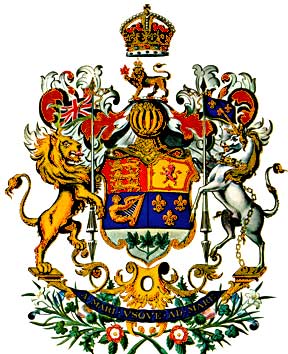
It was decided to make the arms of Canada (or, more properly, the Arms of His/Her Majesty in Right of Canada) very similar to those of Great Britain. The shield was divided into four quarters, with the first three being identical to those in the British Arms: Gules, three lions passant guardant Or, for England; Or, a lion rampant within a double tressure flory-counter-flory all Gules, for Scotland; and Azure, a harp Or stringed Argent, for Ireland. Although these quarters appear in the British arms to represent the fact that these nations are part of the United Kingdom of Great Britain and Northern Ireland, their appearance in the Canadian Arms is meant to represent the fact that these are three of the founding peoples of Canada. The fourth quarter, Azure, three fleurs-de-lys or, of course represents Royal France, thus symbolizing the foundation of Canada by France.
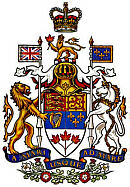 |
| Arms as painted in 1957 by Allan Beddoe |
In the base of the shield was placed a sprig of three maple leaves to represent Canada. It has been theorized that three leaves were chosen to represent the three founding peoples -- French, British, and First Nations -- but it is much more likely that three was chosen because a sprig of three fits elegantly into the space of a shield (see the similar sprigs in Ontario and Quebec). There was some disagreement about the colour of the leaves: Prime Minister Borden thought that the leaves should be red, since maple leaves are most distinctive when red, while the College of Arms thought that they should be green, to signify a young, growing country. A compromise was reached: the leaves were described as "proper", which basically means that they were to be leaf-coloured. Since maple leaves can properly be red, green, or gold, depending on the time of year, it is correct to show them either way.
As supporters, the lion and the unicorn from the British arms were recruited, and differenced by having them hold flags: the English lion holds the Union Jack, while the Scottish unicorn holds the banner of Royal France. Some people mistakenly take the chains worn by the unicorn to signify that the Francophones of Canada are conquered and oppressed, which is untrue. The chains actually signify that the unicorn cannot be oppressed, since the chains are broken and, if reattached to anything, will be broken again. The unicorn with the chain has been used as a Scottish royal symbol since long before the union with England.
The crest is also based on the British one, with the addition of the maple leaf held by the lion. A gold helm of sovereignty and the Royal Crown are also used.
The compartment is a bed of the floral emblems of the four founding nations: the English rose, the Scottish thistle, the Irish shamrock, and the French lily. The motto means "From Sea to Sea", and is taken from Psalm 72: "He shall have dominion from sea to sea".
In 1957, the arms were redrawn to have red leaves, as Borden had intended. This rendition was made by Alan Beddoe, the Founder of the Heraldry Society of Canada, and it became very familiar to Canadians as the version used by the Government of Canada until the mid-1990s. This version also changed the design of the Royal Crown from the "Tudor Crown" depiction used for the previous half-century to one with depressed arches that more closely resembles the actual St. Edward's Crown. Upon her accession, the present Queen indicated her preference for the latter depiction.
| Arms: | Tierced in fess: the first two divisions containing the quarterly coat following, namely, 1st Gules three lions passant guardant in pale or, 2nd, Or a lion rampant within a double tressure flory-counter-flory Gules, 3rd, Azure a harp or stringed Argent, 4th, Azure, three fleurs-de-lis Or, and the third division Argent three maple leaves conjoined on one stem proper. |
| Crest: | Upon a Royal helmet mantled argent doubled Gules the Crest, that is to say, On a wreath of the colours Argent and Gules a lion passant guardant or imperially crowned proper and holding in the dexter paw a maple leaf Gules. |
| Supporters: | On the dexter a lion rampant or holding a lance Argent, point or, flying therefrom to the dexter the Union Flag, and on the sinister A unicorn Argent armed crined and unguled or, gorged with a coronet composed of crosses-patée and fleurs-de-lis a chain affixed thereto reflexed of the last, and holding a like lance flying therefrom to the sinister a banner Azure charged with three fleurs-de-lis Or; the whole ensigned with the Imperial Crown proper. |
| Motto: | A MARI USQUE AD MARE |
| Source: | College of Arms, London, November 21, 1921. |
The present design of the arms of Canada was drawn by Cathy Bursey-Sabourin, Fraser Herald at the Canadian Heraldic Authority, and was approved by H.M. the Queen, on the advice of the Prime Minister of Canada, on July 12, 1994. It includes a new element: an annulus behind the shield bearing the motto of the Order of Canada, Desiderantes Meliorem Patriam ("They desire a better country"). This excellent yet minor addition provoked a great deal of debate (excerpts from Hansard Debates can be found here, which demonstrated a thorough misunderstanding of heraldry by our parliamentarians.
This version has gradually replaced the Beddoe rendition as the one used by the federal government. The use of these arms by the government is determined by the Treasury Board Secretariat through its Federal Identity Program. Generally speaking, the arms of Canada are used by Cabinet ministers, Members of Parliament and Senators, and the federal judiciary.
For detailed descriptions of each of the components of the arms, click here.








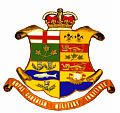
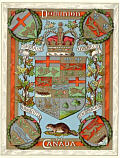
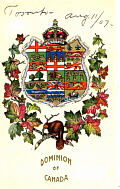
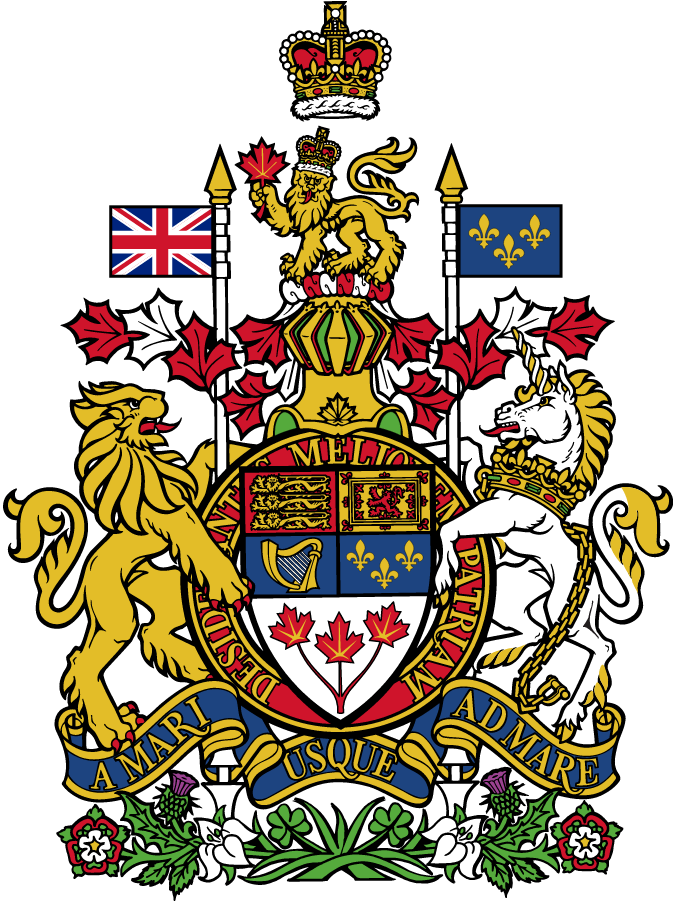
.png)